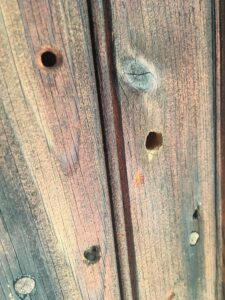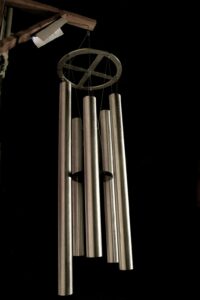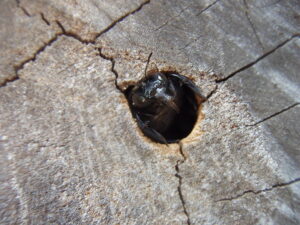CONTENTS

A Homeowner’s Guide: How to Get Rid of Carpenter Bee
Are you tired of watching carpenter bees wreak havoc on your beautiful wooden structures? These buzzing invaders often leave unsightly holes dotting the deck, fence, or even the home’s framework for people worldwide. So, is there any way to eliminate them?
Fortunately, we have a comprehensive guide to arm you with effective, environmentally friendly strategies to send these wooden pests packing. Read on to discover how to get rid of carpenter bees!
What is a Carpenter Bee?

A carpenter bee is a species of bee known for its distinctive habit of boring into wood to make its home. Different from termites, they do not eat the wood but rather excavate tunnels for nesting and laying eggs.
They are typically black and yellow and can be mistaken for bumblebees due to their similar size and color. However, carpenter bees have shiny, hairless abdomens.
While generally harmless to humans, their wood-boring activity can cause vital damage to wooden structures over time, making them a concern for homeowners.
Removing Carpenter Bees
Getting rid of carpenter bees can be relatively straightforward. Follow this simple guide of how to get rid of carpenter bees:
Spray a Residual Insecticide to Kill Carpenter Bees

A quick, simple way to start the purge is by spraying a residual insecticide. This type of insecticide leaves a residue that kills pests after the initial application.
When you spot an active infestation, typically identified by the presence of small, round holes in wood, you should immediately spray the insecticide directly into the carpenter bees’ drill holes where they reside.
The treatment is most efficient when applied twice during the spring at intervals of about 3-4 weeks. Products like Bifenthrin are often recommended for this purpose.
Purchase a Carpenter Bees Trap

If you’re looking for an eco-friendly alternative to chemical methods for removing carpenter bees, try a carpenter bee trap. These traps work by luring the bees into a wooden box with a small hole, mimicking their natural nesting preferences. Once inside, the bees are unable to escape and eventually perish.
The traps are non-invasive and can be placed near areas of infestation, providing a simple, hands-off solution to your carpenter bee problem.
Use Almond Oil

Another natural, non-toxic alternative to deter and remove carpenter bees is using almond oil. They are known to dislike the smell of certain essential oils, with almond oil being particularly effective.
To use this method, you can soak a piece of cloth or cotton ball in almond oil or almond essence, then place it near the bees’ nesting areas or directly into the holes. The scent will repel the bees and encourage them to seek a new location for their nest.
While this method is eco-friendly, it may take longer and require more patience compared to chemical treatments or traps.
Install Chimes or Speakers

Installing chimes or speakers is an unconventional but sometimes effective method to deter carpenter bees. These insects are highly sensitive to vibrations and noise, which can disrupt their nesting behavior.
By placing wind chimes or speakers near the affected areas, you create a disturbance that could potentially drive the bees away. The constant noise and vibration can make the area undesirable for the bees, encouraging them to seek a quieter location for their nest.
Plug Carpenter Bee Holes

Block carpenter bees’ access to their home by plugging the holes. Once you’re sure the bees are not inside (best done in late autumn or early spring when they’re less active), you can plug their holes to prevent them from returning to the carpenter bee nest.
Use a durable material like a wooden dowel, cork, or even steel wool to plug the hole. Seal it with wood putty or caulk and paint over it to match your structure. This can deter bees from re-drilling into the same spot.
However, this method only addresses existing carpenter bee holes and won’t prevent new ones. Combine with other deterrents for better results.
Frequently Asked Questions
How do I recognize carpenter bees?
Carpenter bees are large, about 1/2 to 1 inch in length. They can be distinguished by their shiny, hairless, black abdomens. While male carpenter bees may have a white or yellow face, the females have a black face.
Do carpenter bees sting?
Yes, carpenter bees can sting, but only female carpenter bee has stingers. However, female carpenter bees are not generally aggressive and will only sting if provoked or agitated.
Where do carpenter bees go at night?
As carpenter bees are active during the daytime, they mostly nest in their holes at night.
Conclusion
With the right knowledge of how to get rid of carpenter bees and tools to tackle carpenter bee infestation, it’s entirely possible to reclaim your home from these wood-boring pests. Remember, the key to effective carpenter bee control is early detection, swift action, and preventative measures.
From identifying their distinctive appearance and understanding their behavior to exploring various removal methods like plugging their holes or using carpenter bee traps and deterrents—you’re now equipped with a comprehensive guide to evicting carpenter bees from your property and minimizing carpenter bee damage.
By taking the right steps, you’ll ensure your home remains safe, comfortable, and carpenter bee-free!

